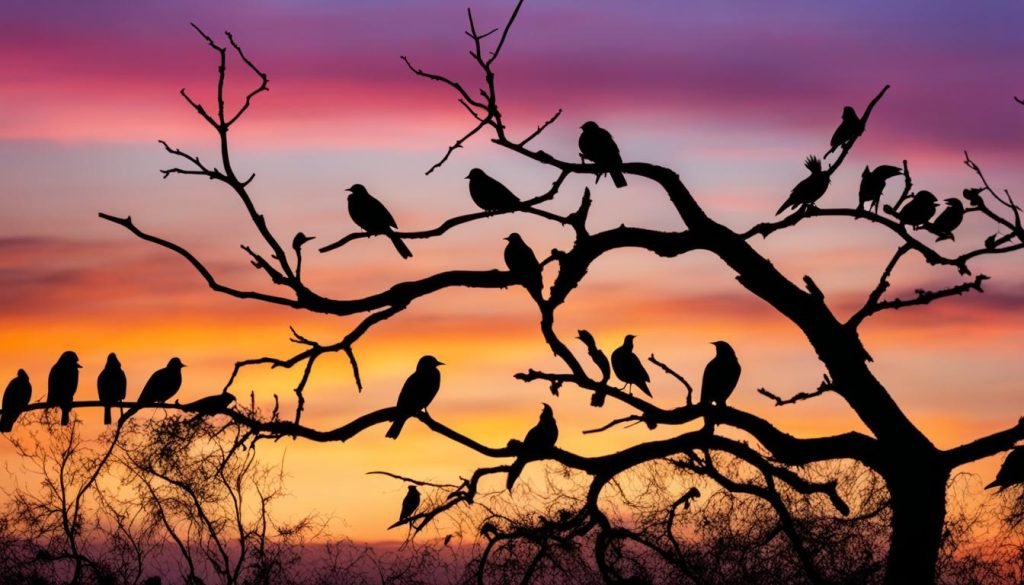How Long Do Birds Live? Avian Lifespan
Birds are some of the most fascinating creatures on our planet, with their incredible versatility, agility, and stunning colors. But have you ever wondered how long these avian wonders live? In this article, we will explore the various factors that impact bird lifespan, from species to environmental factors. We will also examine the aging process that affects bird longevity and its implications for conservation strategies. So, let’s dive into the world of bird lifespan and discover what makes these feathered creatures thrive.
Key Takeaways:
- The lifespan of birds depends on various factors, including species, environment, and genetics.
- Sources of predation, diet, and reproductive patterns are essential factors affecting bird lifespan.
- Avian aging is a complex process influenced by physiological and genetic factors such as oxidative stress and telomere length.
- The knowledge of bird lifespan is valuable when formulating conservation strategies to protect avian populations and habitats.
- The lifespan of different bird species varies considerably, from several years to over half a century.
Bird Quiz
How well do you know birds? Test your knowledge below!

How Long Do Birds Live: What Factors Influence Bird Lifespan?

Various factors can influence the lifespan of birds, ranging from species-specific traits to environmental conditions. Understanding these factors can provide valuable insights into avian lifespans and help inform conservation efforts.
Species
The species of bird can have a significant impact on its lifespan. Generally, larger birds tend to live longer than smaller ones, due to a lower likelihood of predation and a slower metabolic rate. For example, the African Grey Parrot can live up to 50 years in captivity, while smaller birds like warblers typically live for only a few years.
Environment
The environment in which birds live can also play a role in their lifespan. Birds living in urban areas may have a lower life expectancy due to factors like pollution and habitat destruction, while those in rural areas may have access to more resources and live longer as a result. Climate change can also impact bird populations by altering their habitats and food sources.
Diet
Dietary factors can also influence bird lifespan. A well-balanced diet can help prevent disease and promote healthy aging, while a poor diet can have the opposite effect. For example, birds that consume high levels of seed oils may exhibit accelerated aging due to oxidative stress.
Predation
The risk of predation is a significant factor affecting bird lifespan. Birds that live in areas with a high level of predation may have a shorter lifespan due to the increased risk of being killed by predators. This risk can be mitigated by developing protective behaviors and adaptive physiological traits.
Reproductive patterns
Reproductive patterns can also influence bird lifespan. For example, some bird species that breed early in life may have a shorter lifespan due to the energy demands of reproduction. Conversely, species that breed later in life may have longer lifespans as a result of reduced reproductive pressure.
“Understanding the factors that influence bird lifespan is crucial to unraveling the mystery of their longevity.”
Lifespan Variations Among Bird Species

Not all bird species have the same lifespan. There is a remarkable variation in lifespan across different bird species, ranging from just a few years to several decades. Here are some examples:
| Bird Species | Average Lifespan |
|---|---|
| American Robin | 2 years |
| House Sparrow | 4-7 years |
| Bald Eagle | 15-20 years (in the wild), up to 28 years (in captivity) |
| Albatross | Up to 60 years (depending on the species) |
Why do different bird species have such different lifespans? Several factors can contribute to these variations:
- Size: Generally, larger birds tend to live longer than smaller ones. The reason for this is not entirely clear, but it may be related to metabolic rates or stress resistance.
- Diet: Birds with a more varied diet tend to live longer than those with a more limited diet.
- Environment: Some species have evolved to live in harsh environments, which can make them more resilient and longer-lived. For example, the albatross is adapted to life at sea, where it faces few natural predators and has access to abundant food sources, which may help explain its exceptional lifespan.
- Reproductive patterns: In some bird species, individuals who delay breeding or have a lower reproductive output tend to live longer than those who reproduce more frequently.
Understanding the lifespan variations among bird species can help us appreciate the range of adaptations and strategies that birds have developed in response to their unique environments and ecological niches.
Examining Bird Longevity Records

While the average lifespan of birds varies widely depending on species and environmental factors, some birds have achieved remarkable longevity. These birds serve as examples of the upper limits of avian lifespan and provide insights into the factors that influence bird longevity.
“The oldest known bird was an albatross named Wisdom, who lived to the ripe old age of 68.”
The case of Wisdom, a Laysan albatross who hatched in 1951 and was still raising chicks in 2019, demonstrates the impressive longevity that some birds can achieve. Albatrosses are known for their long lifespans, with some individuals living for several decades.
Other birds that have lived exceptionally long lives include:
| Bird Species | Recorded Lifespan |
|---|---|
| Greater Flamingo | 83 years |
| African Grey Parrot | 49 years |
| Black Swan | 40 years |
These remarkable cases of avian longevity highlight the potential for birds to live longer than we might expect. However, it is important to note that these birds are the exception rather than the norm, and most birds have much shorter lifespans.
By studying the factors that contribute to bird longevity, we can gain a better understanding of how to protect and conserve bird populations. The next section will examine the environmental factors that impact bird lifespans.
Environmental Factors and Bird Lifespan

In addition to genetic and physiological factors, environmental conditions can significantly impact bird’s lifespan.
Habitat degradation, climate change, pollution, and other human-induced factors have been linked to reduced bird populations and shorter lifespans.
| Environmental Factor | Influence on Bird Lifespan |
|---|---|
| Habitat Loss and Fragmentation | Reduces available resources and breeding opportunities, increasing stress and decreasing lifespan |
| Climate Change | Altering migratory patterns and disrupting breeding cycles, potentially leading to population declines |
| Pollution | Exposure to toxic substances can affect breeding success and impair immune function, increasing susceptibility to disease |
Moreover, birds are also vulnerable to habitat destruction caused by natural disasters such as wildfires, floods, and hurricanes.
As conservation efforts become increasingly urgent, understanding the environmental factors influencing bird lifespan becomes vital. Protecting habitats, reducing pollution, and mitigating the effects of climate change can help preserve avian populations and promote their longevity.
Understanding Avian Aging Processes
Factors influencing bird lifespan are complex, and avian aging processes play a fundamental role in determining how long birds live. Several factors contribute to the aging of birds, including cellular senescence, oxidative stress, and telomere length.
Cellular senescence refers to the gradual loss in cell functionality as cells divide multiple times during an organism’s life. In birds, this can lead to a decline in tissue repair and overall health, impacting longevity.
Oxidative stress occurs when an abundance of reactive oxygen species (ROS) leads to cellular damage that, over time, can accumulate and contribute to aging. Environmental factors such as pollution and toxins can contribute to oxidative stress in bird populations.
Telomere length also affects the avian lifespan. Telomeres are the protective caps at the end of chromosomes that degrade as cells divide. Over time, telomere shortening can contribute to cellular damage and the onset of age-related diseases.
“Telomere length can be considered as a ‘biological clock’ of cells, reflecting the potential for continued cell division and, hence, longevity.” – Paul H. Walton
Understanding the factors that influence bird lifespan and the physiological processes that contribute to aging provides valuable insights for conservation efforts. Studies on aging and longevity in birds can help develop strategies to protect bird populations and promote their long-term survival.
Implications for Conservation Efforts
Understanding bird lifespan factors and bird longevity is essential for effective conservation efforts. With bird populations declining globally, it is imperative to develop strategies that can protect birds and their habitats. By studying the average lifespan of birds and the factors that influence their longevity, conservationists can gain valuable insights that can help them create effective conservation plans.
For instance, knowing the bird lifespan information of endangered species can help in designing customized protection plans to ensure their survival. Similarly, understanding how environmental factors impact bird lifespan can help identify areas that require urgent conservation action.
Moreover, knowledge about bird longevity can also help in identifying species that are more vulnerable to human-induced changes and those that can adapt to changing conditions. This information can enable conservationists to focus their resources on the most critical areas while also developing plans that can cater to the unique needs of different bird populations.
In conclusion, understanding the average lifespan of birds and the factors that influence their longevity is crucial for successful conservation efforts. It can help in designing effective conservation strategies, protecting endangered species, preserving bird habitats, and ensuring the long-term survival of avian populations.







